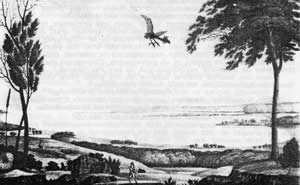
 |
| Fossilised Mudchook |
"Mudchook" is the name given to a prehistoric bird from the Triassic Period that resided in what is now the Lake George region of New South Wales, Australia.
It is theorised that fossilised remains were probably unearthed during World War II, when a wooden 'dummy' ship was floated on the lake and used for bombing practice by the Royal Australian Air Force. When the lake dried up in November 2002, a group of local rugby enthusiasts came across the fossils while participating in some intensive training on the lakebed in preparation of the upcoming season.
 |
Early Painting of Lake George Area
[apologies to Joseph Lycett & John Woolley] |
The fossils were given to the Australian National University's Paleontology department for analysis and to trace the evolutionary history of this exotic creature. Research revealed the creature to be a ground nesting, flightless bird with certain enlarged features. Due to these findings it was given the scientific name "Neomegaboulepteryx", but aptly nicknamed the "Mudchook" due to its disproportionately large genitals, which would drag through the mud flats of Lake George when it ran.